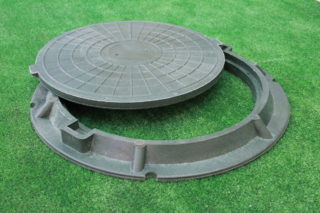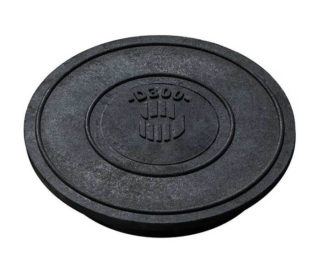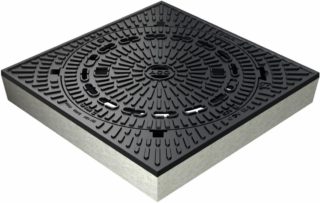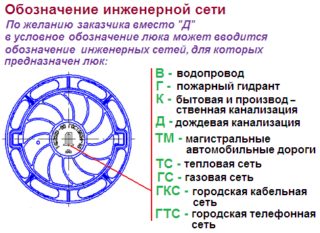After installing the sewage system, it is necessary to select a device for closing the inspection well. It is installed flush with the ground or buried. The main requirement for a cover for such communication is reliability and resistance to stress.
Purpose of covers for sewer wells

Overlappings for manholes are made of two parts: a cover and a support ring. They are used in systems in which the presence of inspection wells is provided. Each hydraulic structure must be properly operated and its aboveground and underground elements must be protected from damage. For this, wear-resistant well hatches are used, which:
- block the well shaft from debris, foreign objects;
- ensure the safety of humans and animals;
- protect from the characteristic sewer odor;
- prevent atmospheric precipitation from entering the drains;
The covers are also used for decorative purposes - they add aesthetic appeal to the hydraulic structure and harmoniously fit into the surrounding landscape. If the appearance of the sewer hatch does not suit the owner of the site, it can be masked with decorative stones or a pot of flowers.
Model classification
In order for the cover of the sewer well to fit perfectly, it is necessary to take into account various parameters: from the material of the cover to the possible level of load.
Production material
Well floors can be classified according to the material used to make them. Sewer hatches must meet increased requirements: strength, resistance to wear, resistance to deformation and mechanical stress, to corrosion and mold. Products must maintain performance under the influence of temperature changes.
The following types of covers meet all these criteria:
- polymer-composite or polymer-sand;
- concrete;
- cast iron;
- plastic.
The traditional material for lids is cast iron. It is appreciated by manufacturers for its strength, long service life and excellent resistance to aggressive influences.

Coverings made of polymers for sewer wells have many advantages over cast iron models: they weigh less, look more beautiful, and are cheaper. Moreover, they are quite strong, practical and durable.
Their service life is calculated for several decades due to the material's insensitivity to the effects of atmospheric influences and a low coefficient of thermal expansion.
Polymer covers are perfectly installed on the seats of hatches, delivered many years ago.
Due to technological diversity, polymer manhole covers are manufactured for specific operating conditions. In places that are not subject to serious loads, they use less durable, inexpensive, lightweight and easy-to-use models.
A polyethylene or polypropylene cover for a well cannot be installed on highways - it will not withstand the load. Better to choose a cover made of metal or fiberglass and polyester resin. But for a summer cottage, polyethylene or polypropylene is quite enough.
Concrete well plugs are made for laconic structures from reinforced concrete rings.Overlappings of this type are made both monolithic and with a hinged wooden or plastic shutter. Instead of a door above the hatch, you can build a brick or wood superstructure. In suburban construction, such ceilings are used to seal septic tanks and cesspools.
Load and marking
To choose the right well floor, you need to know the standard markings. It is indicated on each product with specific letters:
- PG - for underground fire hydrants;
- TS - for inspection manholes of heating systems;
- D - for storm water inlets and sewage structures;
- K - for sewage and fecal systems;
- B - for inspection hatches of water supply lines;
- M - for gas pipelines;
- T, MTS, GTS - for telephone lines.
Heavy hatches can hold loads of no more than 15 tons. Usually, this type of sewer cover is used on industrial areas or city highways that are not intended for the passage of heavy special equipment.
Heavy main sewerage ceilings hold loads up to 25 tons per second. Their installation is carried out in places with the systematic passage of a large number of trucks and other large vehicles. Such coatings are installed at gas stations, highways, and berths. Super heavy covers are used where load capacity is over 25 tons per second.
Sometimes covers are equipped with locking mechanisms to prevent theft and accidental opening. Locks are spacer, flag and threaded.
Shape, sizes and prices
The most popular lids are round and square. The first ones are produced with diameters from 35 to 120 cm, which allows them to cover a septic tank, caisson, well. Gosstandart offers two traditional sections - 45 and 55 cm.

Square covers and ceilings are used for wells, on which, due to their shape, it is not possible to install a rounded hatch. The main area of their use is elements of the stormwater (storm inlet) system and inspection hatches of water mains with the upper part made of a log house, and not on the basis of a reinforced concrete ring. Covers in the shape of a rectangle or a square are produced in sizes 300-800 mm on the side. They are sealed and with slots for storm water drainage.
To select a well hatch, you need to remove the exact dimensions of the inner and outer head of the well. The cover should overlap the well so that no foreign objects get inside. It is possible to adjust the dimensions of the polymer well manhole and the head by using a reinforced concrete ring as a base.
The price of a plastic or polymer-sand cover for a sewer well starts at 500 rubles. The cost of a cast iron product is from 2000 rubles. The minimum price of a concrete floor is about the same.
With the correct selection and installation of the cover for the sewer well, there will be no unpleasant odor on the site. The hole itself will merge with the background of the surrounding landscape.









